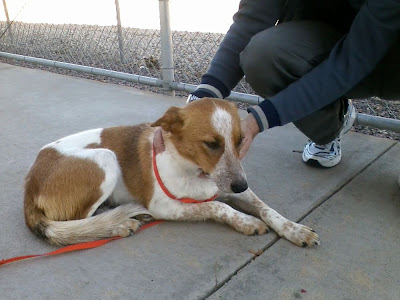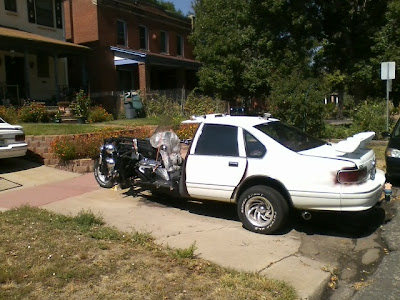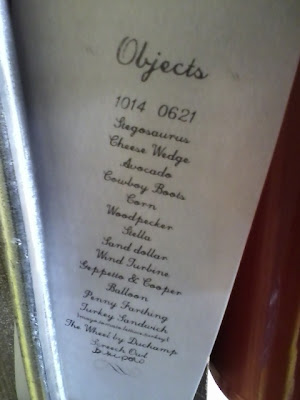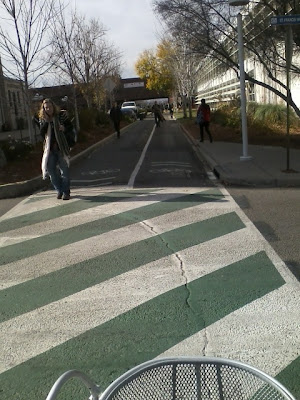 |
| More mountain biking, please. |
Scout and I took
Surly and
Salvagetti up on their invitation to experience the
Unicorn Petting Zoo, not far from where we live. As promised, the event included many mystical steeds, free not only for petting, but for riding around in a magical alpine setting. To the delight of all involved, it turns out these unicorns were shod in fat rubber.
 |
| Scout tracking elusive beasts. |
 |
| In our pursuit, we wended our way along a section of the Colorado Trail... |
 |
| ... and through an area that burned about a decade ago. If you squint your eyes, you might just make out a grazing unicorn among the charred trunks. |
 |
| We were getting close. Those aren't anemic, skinny-tired bike tracks. |
Through the assistance of some Surly elves, I was able to wrangle a wily
Krampus for a ride. It's a unique and highly inspired thing; a convergent product of two evolving forms of off road machinery. Surly has been central to the development of both antecedent gene lines, 29er and fatbike, so the cross-pollination that led to the Krampus is no surprise. Think of it as the offspring of a Karate Monkey and a Pugsley, with a bit of beneficial spontaneous mutation.
The Krampus rides a lot like a 29er, because it is. It also rides quite a bit like my Pugsley, largely because of the fat 3-inch wide tires at low pressure. Then again, it exhibits the characteristics of just about any rigid off road bike, with perhaps just a bit of something more. It is, in many respects, a sense of more-ness that is probably most descriptive of riding a Krampus.
The following is by no means a review, but instead impressions of spending a half hour or so on the trail with a Krampus. This bike is full of innovations and is legitimately boundary-pushing. In short, it's chock full of more-ness, as previously mentioned. If you're a fan of fun bikes, or of getting a sneak glimpse of the not-so-distant future, it's a bike that you would do well to find a way to take a ride on, or at least to ponder.
Although it is probably not overwhelmingly light on the scale, the Krampus feels light on the trail. The fat rubber eats up trail obstacles and smooths the ride, creating the impression of easy acquisition of speed. It floats and hops readily, but with those big wheels spinning, it stores enough embodied energy to maintain considerable momentum to roll up small rises with minimal effort.
 |
| Why didn't I think of that? The Surly Krampus is a conglomeration of several deceptively simple, great ideas. |
 |
| Color doesn't make or break a bike, but photos can't convey how terrific the metallic green looks on the frame. |
 |
| The Krampus has a lot going on in the front end. More on that in a bit. |
 |
| With the Krampus, Surly has brought into focus a re-imagined trail bike. I predict that in a few years, there will be no shortage of manufacturers offering bikes with many of its features. |
Perhaps one of the oddest things about the Surly Krampus is that it uses mostly normal parts. It takes a 100 mm front hub and a 135 mm rear. It has a 73 mm bottom bracket, and a 44 mm headset, which, although it's a size new to me, I'm told is standard to many newer bikes. All this means that a Krampus frame is ready to receive parts from just about any existing bike a prospective owner may already have.
However, going with the theme of more-ness, the parts that are different on this bike make for an end product with more capabilities. It's designed to use 50 mm wide 29er rims with 29" x 3.0" knobbies. Important to note is that those two items did not exist prior to this bike. A fat-tired 29er previously topped out at about 29" x 2.4" tires on 35 mm wide rims. The extra dimensions translate to delivering a ride that is more cushioned, grippy and confidence inspiring. Somehow it just feels right, as if this is how a rigid mountain bike is meant to ride.
However, what makes the bike is not all about its ability to encompass fatter rubber. In purely aesthetic terms, the powdercoat on the Krampus is likely to turn the world of bike colors on its head. Surly has long been known for love-it-or-hate-it colors, most of which are monochromatic. I find this refreshing when compared to other manufacturers who slather on a lot of graphics and racing stripes in overly complicated patterns. The deep metal flake finish on the Krampus that they've termed 'Moonlit Swamp' is simply amazing, yet maintains the design simplicity of its earlier paint schemes. It's reminiscent of a nice metal flake finish on a fiberglass speedboat, circa 1975. I'll admit that green is my favorite bike color, but man, does this powdercoat look good.
Another innovation subtly integrated in this bike is the use of single-wall, cut out rims on a bike overtly promoted as being a trail bike. The inclusion of these rims may be a game changer in a number of respects. It signals that lighter, wider rims may be good for much more than just the snow or soft surfaces for which they were seemingly originally intended. These rims probably have a strength threshold short of downhilling or acrobatics, but are apparently just fine for regular use.
 |
| As wide as the length of my index finger on my size L/XL hands. |
 |
| Enough room for mud clearance, even fenders, if so inclined. |
 |
| The specially shaped yoke joining the bottom bracket to the chainstays is perhaps the central key to the whole bike. |
 |
| The Surly Rabbit Hole rims are somewhat concave on the inner face. |
The Krampus does more with available space by doing what Captain Kirk would do: rewriting the rules to serve its own needs. Instead of deferring the arbitration of maximum tire width to the limitations of existing design, some Surly engineer re-configured the chainstay to bottom bracket connection to provide enough clearance for fatter tires while still allowing room for chainrings, all with a standard bottom bracket shell width. Success in this area appears to have been the crux, past which the rest of the bike was able to come into being. Give that engineer a raise.
The design around the bottom bracket makes a strong structural suggestion in favor of a single, or at least a more outboard double chainring setup, as enabled by
offset double cranks. Running a single ring in front with a wide range cassette out back is becoming more of an accepted way of doing business for many mountain bike designs. It makes a lot of sense, and reduces some mechanical complexity to run a 1-by-whatever drivetrain. However, as with anything regarding bike setup, personal preferences come into play. The test bike that I rode had a 39-tooth ring, which left me wanting a lower gear. A 34 or 32 up front would have been more ideal for me.
The Surly Krampus features an astonishingly wide handlebar, to wit, a 780 mm wide Salsa Whammy bar. I have long been a fan of wide bars, but this was easily the widest I've ridden. The effect was to force the bike to submit to my complete control through superior leverage. Here, once again, more is more. The super wide bars somehow make the bike more nimble and controllable, with solid reinforcement in the knowledge that the bike would go precisely where I told it to go. The enormity of this bar seems to be the central element around which the front of the bike was built. The bar deserves no small credit in imparting supreme confidence while on the trail, and feels in perfect proportion with the rest of the bike.
 |
| Salsa Whammy bar on a Surly Krampus. The combo will put hair on your chest. |
 |
| My elbow is even with the end of the bar. For reference, I'm about 6'2" and standardly proportioned. |
 |
| Salsa Whammy bar. It says 11 degrees on the front, but that could just as easily stand for turning up steering control to 11. |
I came away from my time with the Surly Krampus quite impressed with its more-ness. My immediate reaction was that I had just ridden the bike that will retire the 26-inch wheeled mountain bike from serious off-road consideration, perhaps permanently. There are enough clear advantages to nicely fat tires on large diameter wheels to call into question the wisdom of riding anything smaller.
The rolling diameter of a standard 29er, among which I would include 26" x 4.0" or larger tires, just makes for a better, smoother ride as compared to the traditional 26" x 2.X combo. I don't make this assessment lightly, as I have more than 25 years on traditional 26-inch mountain bikes. However, it may more accurately be that my realization was that, for me and/or people around my height, traditional 26ers are out of proportion and have probably always been. I'm not yet certain of this, and probably only time will tell.
Another impression I had was that, apart from the differences in wheels and tires, the Krampus felt a lot like my Pugsley. After talking with the Surly guys a bit, I discovered that Krampus wheels and tires suitably built to fit my frame should imbue my Pugsley with ride qualities much the same as the Krampus. This has left me with something to ponder, and for the weighing of finances.
So, as I established that my Pugsley can handle 29" x 3.0" tires on suitable rims, I also determined it can handle tires more likely to be found on a Moonlander. There were so many fatbikes around that I easily found a bike similar to mine, but sporting fatter tires. I already knew that I could swap a 4.8" tire for my 3.8" on the front of my bike because I have a Moonlander fork, but apparently a 4.8" will also work on the rear, provided I cull a few of the smaller cogs from my cassette so that the chain doesn't rub on the sidewall of the tire. That's a sacrifice I'd be willing to make. So now I'm left to weigh the benefits of even fatter rubber for my bike. Decisions, decisions.
What it all amounts to is that the Pugsley, a perhaps somewhat overlooked grandfather of modern fat bikes, is able to run tires from the current spectrum of fatbike possibilities. The Moonlander's offset of 28 mm in the rear is more than a 29er wheel can easily be built to handle, so Krampus wheels seem unlikely on a Moonlander. Likewise, a Krampus can't handle 26" x 4.0" tires. Therefore, I left appreciating the adaptability of my Pugsley all the more.
 |
| My Necro Pugsley front end with a 3.8" Larry in a Moonlander fork. |
 |
| Another Necro Pugsley with a 4.7" Big Fat Larry, also in a Moonlander fork. |
 |
| A nice n' beefy Surly Lou 4.8" tire on a 100 mm Clown Shoe rim, in a Moonlander. |
After the bike riding and mucking about was mostly over, the die-hard core gathered around a fire for some brew and hobnobbing. I hadn't been to Buffalo Creek before, but it reminded me a lot of the rock formations at Happy Jack and Vedauwoo in southeastern Wyoming. It's more populated than Wyoming, but a bit closer and easier to get to, so I'll be back.
 |
| Time for a fire. |
Scout, who is often aloof around other people, kept at a distance from much of the activity. She occasionally exhibits cat-like tendencies, and true to form, she found an elevated notch in a boulder of sculpted granite from which she could view what was going on around her. She snuggled in while I boiled water for tea and dried soup. She was more than happy for me to share food with her, and especially appreciated the summer sausage.
 |
| Scout in a rare photo: one in which she's not blurred due to movement. |
 |
| I think she may have actually been tired by this point. |
 |
| My pop can stove getting the job done. |
A while later, a trailer-mounted wood-fired pizza oven showed up and the level of cuisine dramatically increased. It's going to be hard to top having freshly baked pizzas with creative toppings immediately adjacent to the campsite.
 |
| Phil at work making what ended up being a calzone. |
 |
| The fiery furnace of the wood oven. |
 |
| This tomato basil slice tasted even better than it looked. |
I couldn't stay up as long as the younger and/or more inebriated contingent present. That meant I was up before all of them, so Scout and I took a walk.
 |
| Basic Kneads is the pizzeria on a trailer pictured here. Highly recommended. |
 |
| A Surly Krampus with a suspension fork and a flat tire. |
 |
| Phil's half fat Karate Monkey. The cage on the fork ensures that he's well prepared for morning rituals. |
 |
| My Coleman Feather 442 stove and pop can stove are both in action for breakfast. |
After breakfast, Scout and I took another ride along the nearby Colorado Trail. The sun had only recently come up, and was still only occasionally visible between the trees. We had the trail all to ourselves and followed its undulating rise and fall as it rippled across a valley and up the side of a hill. Scout kept pace with me perfectly and made many orbits of me and the bike in conjunction with obstacles. She's blossomed into a full-fledged trail dog.
 |
| Furry paws and fat tires. |
 |
| The part of the grizzled old prospector is played by me. |
 |
| The Colorado Trail is well-marked and easy to follow. |
 |
| At trail speed. |
 |
| The trail gets swoopy through these rocks. |
 |
| Bike and dog are both well adapted to their purpose. |
Surly and Salvagetti put on a good party, and I'm sure that it will result in bikes and parts sold to people who will make good use of them. It was great to be able to sample and peruse a range of bikes that are not always readily available. I think the main outcome of this whole enterprise is to underscore the idea that fatbikes are not just for snow or sand anymore.
 |
| A pile of PBR cans seems to often be in the wake of Surly bike people. Perhaps it's unicorn fuel. |
 |
| Phil had the best camping rig of the group. You can't really top a Volkswagen camper for this type of event. |
 |
| The most fat tires I've seen in one place at one time. |






















































